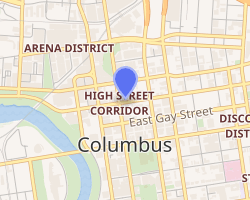Atlas Building
The Atlas Building is a structure located in Columbus, Ohio originally built in 1905. It was added to the National Register of Historic Places in 1977.
Columbus Savings and Trust Building | |
_-_6032788761.jpg) The Atlas Building in 2010, before its renovation | |

Interactive map highlighting the building's location | |
| Location | 8 E Long Street Columbus, Ohio |
|---|---|
| Coordinates | 39°57′54.594″N 83°0′2.567″W |
| Built | 1905 |
| Architect | Frank Packard |
| Architectural style | Second Renaissance Revival, Sullivanesque |
| NRHP reference No. | 77001060[1] |
| Added to NRHP | September 15, 1977 |
History
The Atlas Building was originally the called the Columbus Savings & Trust Building, and was designed by prolific Ohio architect Frank Packard.[2] The Building was built for the Columbus Savings & Trust Company, then based in the Spahr Building at 50 East Broad street.[1] Ground was broken for construction in May 1904.[3] The construction project of the building, estimated at $500,000, was awarded to the Chicago-based firm John Griffiths and Son, who completed the building in 1905.[4] After the Columbus Savings and Trust Company filed for bankruptcy, the building was acquired by Depositors Realty Company in 1913.[1] That same year, the Atlas Building served as the original headquarters of the Athletic Club of Columbus.[5] The building was added to the National Register of Historic Places on September 15, 1977.[1]
Renovation

The Atlas Building underwent renovation in 1982 under the direction of architect David C. Hughes, who restored storefronts using precast colored concrete.[6] In 2014, the building underwent a $20 million renovation by real estate developer Michael Schiff of Schiff Capital Group.[7]
References
- "National Register Information System". National Register of Historic Places. National Park Service. March 13, 2009.
- "Packard, Frank Lucius". Knowlton School of Architecture. The Ohio State University. Archived from the original on February 4, 2017. Retrieved February 3, 2017.
- "Columbus02861a". Columbus Memory. Columbus Metropolitan Library. Archived from the original on February 11, 2017. Retrieved February 9, 2017.
- Wartenberg, Steve (October 16, 2013). "Century-old Atlas Building bringing more upscale living Downtown". The Columbus Dispatch. Archived from the original on February 4, 2017. Retrieved February 3, 2017.
- "Our History". Athletic Club of Columbus. Archived from the original on February 4, 2017. Retrieved February 3, 2017.
- Darbee, Jeffrey T.; Recchie, Nancy A. (2008). The AIA Guide to Columbus. Ohio University Press. p. 131. ISBN 9780821416846.
- Rose, Marla Matzer (March 2, 2011). "Atlas' newest owner wants to turn it into apartments". The Columbus Dispatch. Archived from the original on February 4, 2017. Retrieved February 3, 2017.